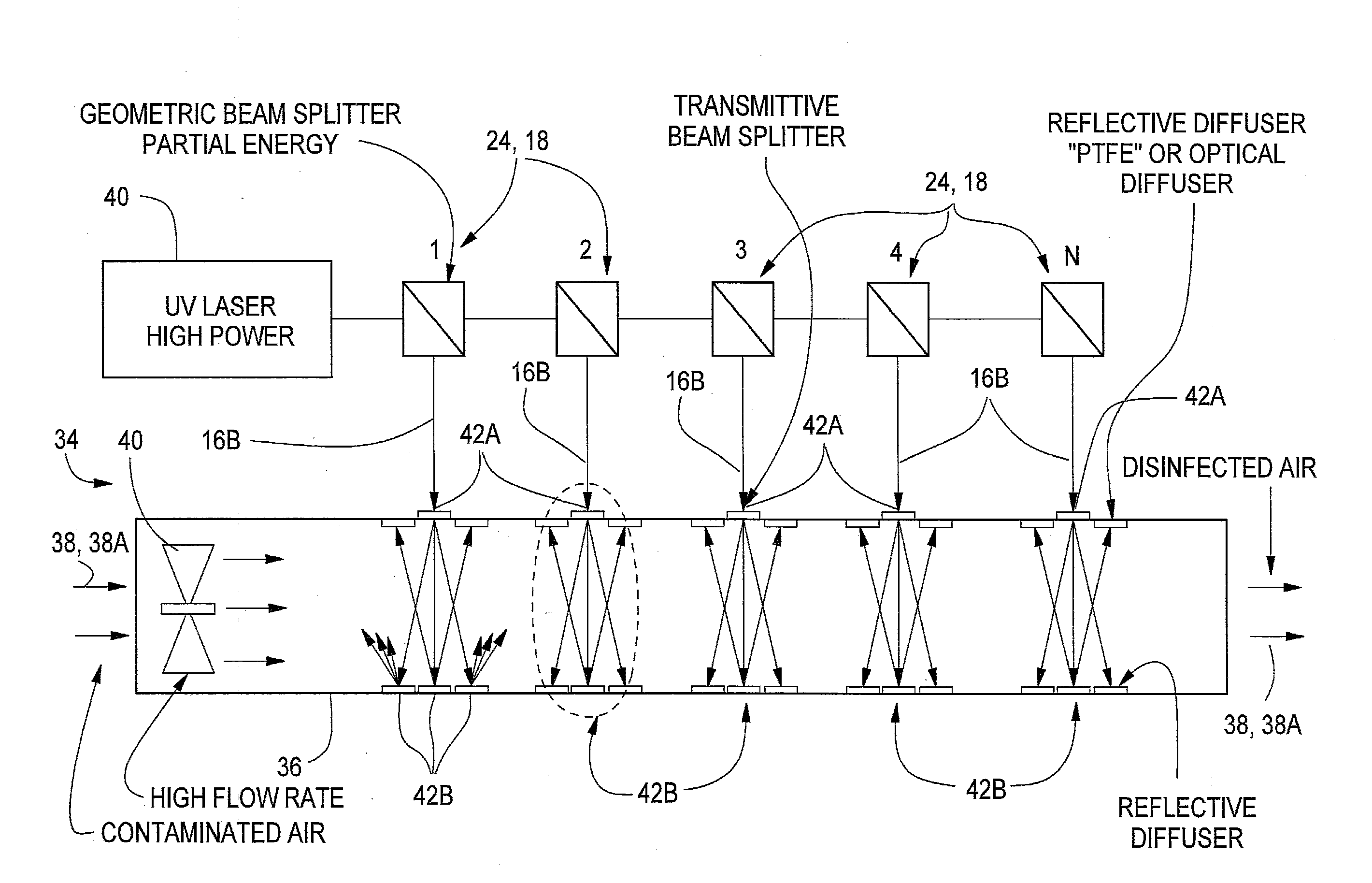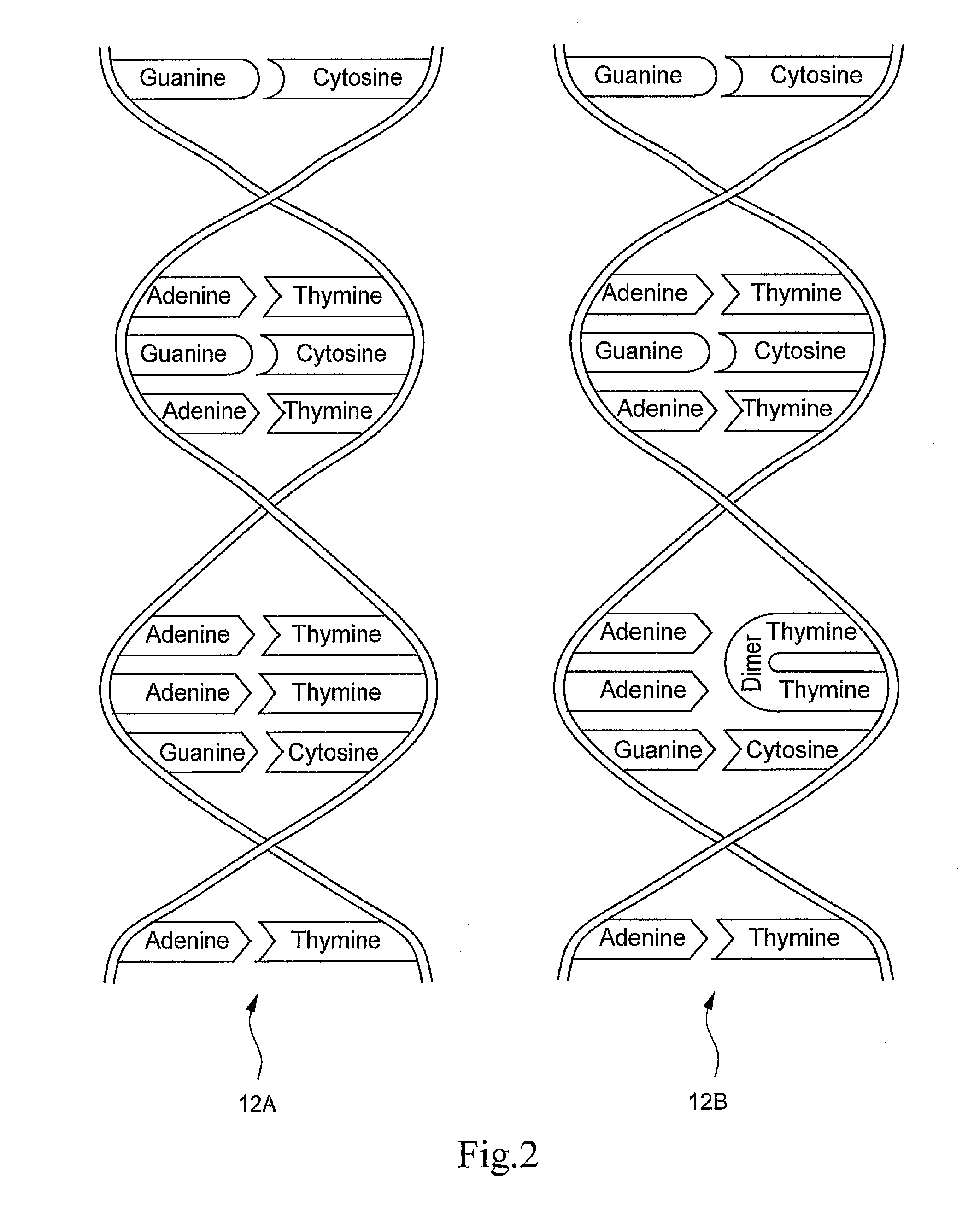UV radiation does so by destroying their ability to multiply, thereby defeating their ability to cause
disease.
More specifically, UV-C light causes damage to the
nucleic acid of the microorganisms by forming covalent bonds between certain adjacent bases in the
DNA.
The formation of such bonds prevents the
DNA from being unzipped for replication, and the
organism is unable to reproduce and, when the
organism tries to replicate, it dies.
In this regard,
UV disinfection is unique in that the UV radiation energy is absorbed by the fluid in which the microorganisms are suspended, leading to non-uniform
fluence rates.
In other words, the non-uniform disinfection rates caused by the non-uniformity of
fluence rate can severely limit disinfection efficiency especially when liquid foods with
high absorption coefficients are treated, which is a factor which must be considered when designing
UV disinfection systems.
Current UV radiation treatment systems, however, including AOP systems, are disadvantageous in that they typically heavily rely on a technology that has not changed drastically over several decades.
These types of lamps also generate IR radiation and
broad spectrum UV, so that there are heating and aging issues, including solarization of the glass housings which, in turn, can reduce their effective lifetime.
Another issue is that
UV treatment systems, using low to
medium pressure mercury lamps, typically employ a method of
light delivery that is rather crude, using simplistic tubular window designs that are geared toward
broadcasting the UV and other spectrums of radiation emitted from the lamp over a general area.
Furthermore, the removal of
suspended solids or particulate matter is important in order to ensure that the
water treatment is adequate because this type of debris in the water can shield microbes from the UV light as they pass through the
UV treatment system, which is an unacceptable situation with grave consequences when considering the treatment of drinking water or ultra pure
water treatment facilities for medical and biomedical applications.
Again, however, current air and surface treatment systems heavily rely on the same basic technology as used in the disinfection of water, which as described above has not changed in several decades.
As also described above, these types of lamps also generate IR radiation and
broad spectrum UV, resulting in heating and aging issues, including solarization of the glass housings, that can reduce their effective lifetime.
Within an air handling environment, the conduction of heat from the tubes relies on a less efficient
convection than occurs in
water treatment systems and, with the resulting contrast in heating and cooling, it is possible for condensation to form, which can cause
adverse conditions that might allow airborne contagions to escape, such as through drainage areas.
Another issue is that UV
air treatment systems using low to
medium pressure mercury lamps typically employ a method of
light delivery that is again rather crude, using simplistic tubular window designs that are geared toward
broadcasting the UV and other spectrums of radiation emitted from the lamp over a general area.
The UV
bulb or UV lamp systems of the prior art also suffer from a number of other clear disadvantages.
A lamp /
bulb radiation intensity pattern can, however, be unpredictable from
bulb to bulb or lamp to lamp, so that it is difficult to adequately model the radiation levels and profile to be obtained from a given design.
In a number of such systems, however, the radiation from the lamps or bulbs does not span the entire width or length of the duct, so that any assumption and use of
complete mixing tends to result in larger errors compared to unmixed flow.
The efficiency of such systems will tend to fall somewhere between those of systems which assume
mixed flow and systems which assume unmixed flow, which limits the efficiency of such systems as well as the accuracy by which the efficiency of such systems may be evaluated, thereby requiring at least the use of redundant lamps or bulbs in order to ensure a minimum acceptable level of efficiency.
The problem with current duct systems is, however, that the diffuser properties are not predictable and produce intensity variations, creating further problems with modeling the disinfection capability or efficiency of the system.
Polished aluminum is highly reflective of UV wavelengths, but is susceptible to oxidation, while
copper, which reflects most visible light, is transparent in the UV range, and galvanized steel, which is typically used in
HVAC (heating, ventilating and
air conditioning) duct systems, has poor
reflectivity in the UV range.
In other related problems, it must be noted that there presently exists no simple method of calculating the three-dimensional UVGI intensity field for specular or diffuse reflectors for lamp or bulb UV sources.
Ray-tracing routines, using Monte Carlo techniques, are one approach, but the results do not easily lend themselves to analysis.
 Login to View More
Login to View More  Login to View More
Login to View More 


